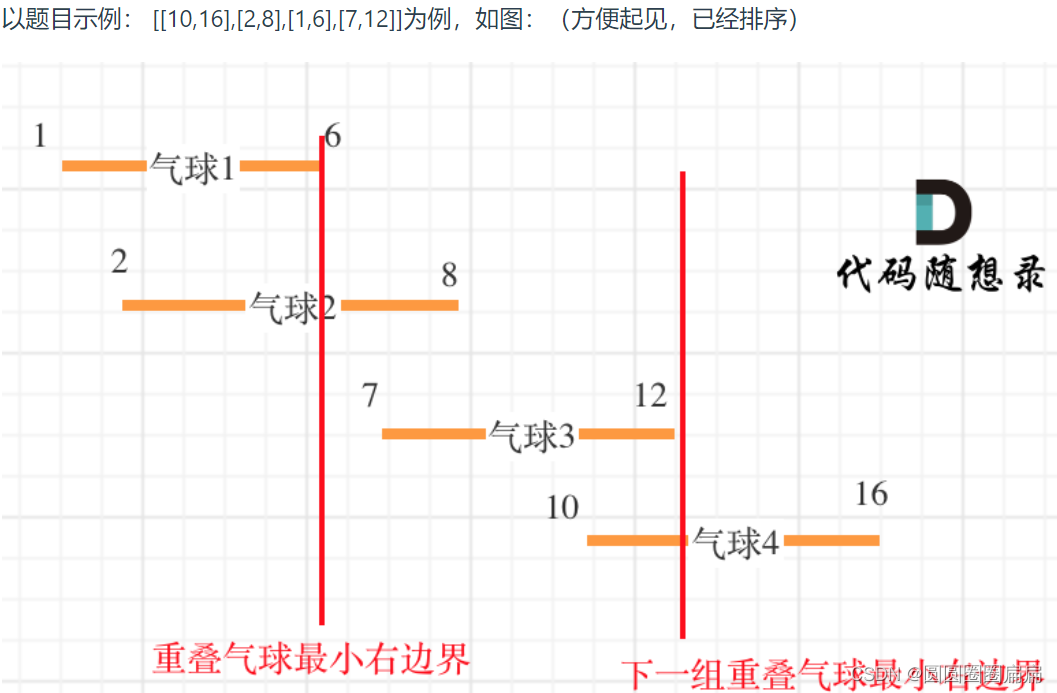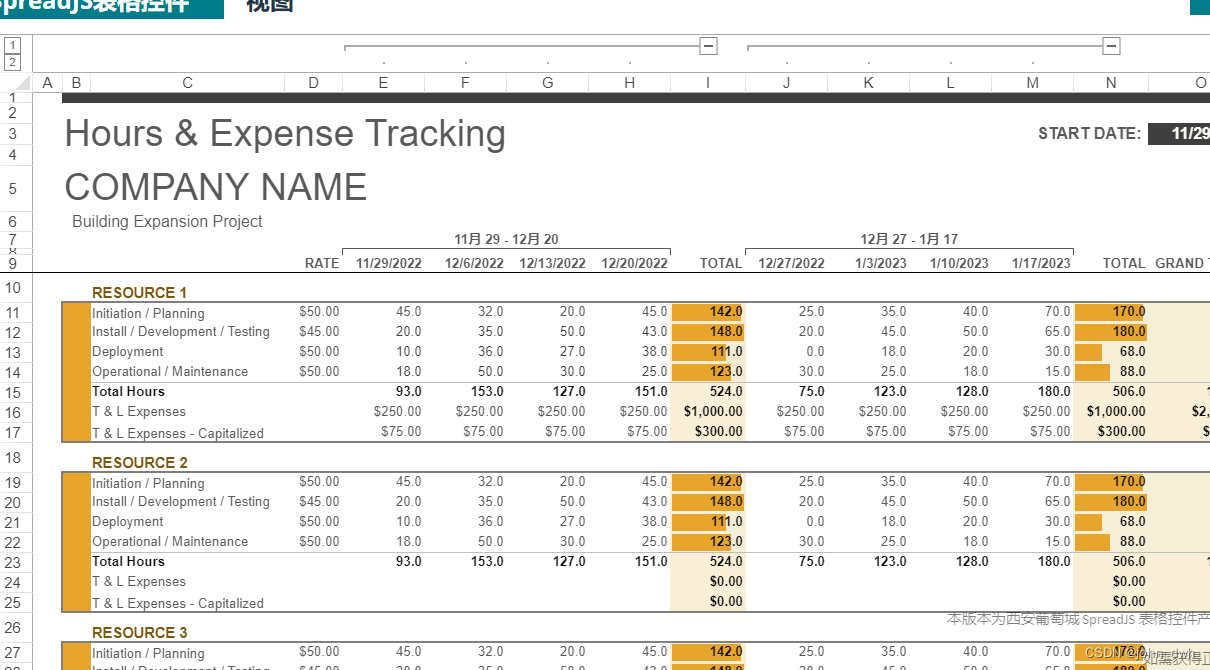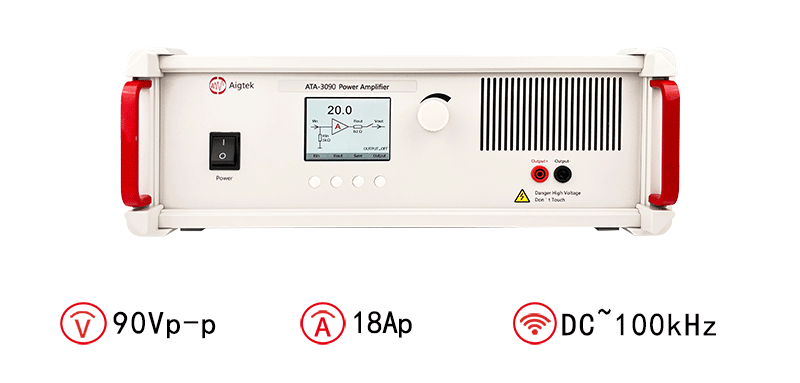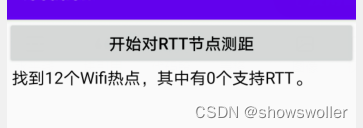文章目录
- 第48讲:基于SPI协议的Flash驱动控制
- 0. 理论部分
- 1. Flash全擦除实验
- key_filter
- flash_be_ctrl
- spi_flash_be
- tb_flash_be_ctrl
- tb_spi_flash_be
- 2. Flash扇区擦除实验
- key_filter
- flash_se_ctrl
- spi_flash_se
- 3. 数据读操作
- key_filter
- uart_tx
- flash_read_ctrl
- spi_flash_read
- tb_spi_flash_read
- 4. 数据页写操作
- key_filter
- flash_pp_ctrl
- spi_flash_pp
- 5. 数据连续写操作
第48讲:基于SPI协议的Flash驱动控制
0. 理论部分
SPI(Serial Peripheral Interface,串行外围设备接口)通讯协议,是Motorola公司提出的一种同步串行接口技术,是一种高速、全双工、同步通信总线,在芯片中只占用四根管脚用来控制及数据传输
应用:EEPROM、Flash、RTC、ADC、DSP等
优缺点:全双工通信,通讯方式较为简单,相对数据传输速率较快;没有应答机制确认数据是否接收,在数据可靠性上有一定缺陷(与I2C相比)
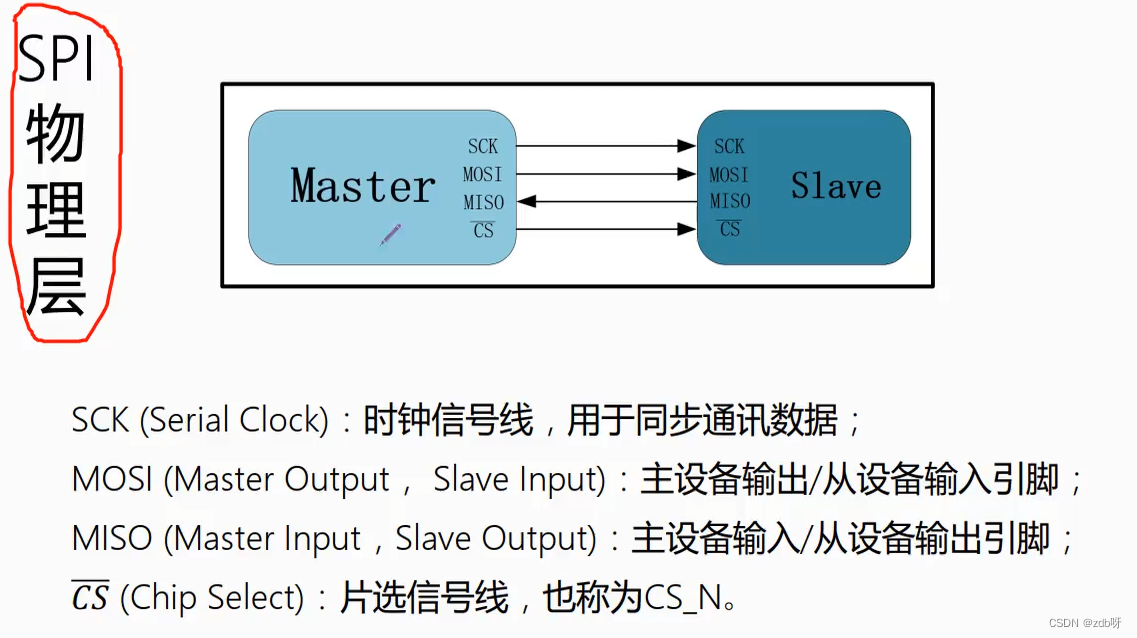
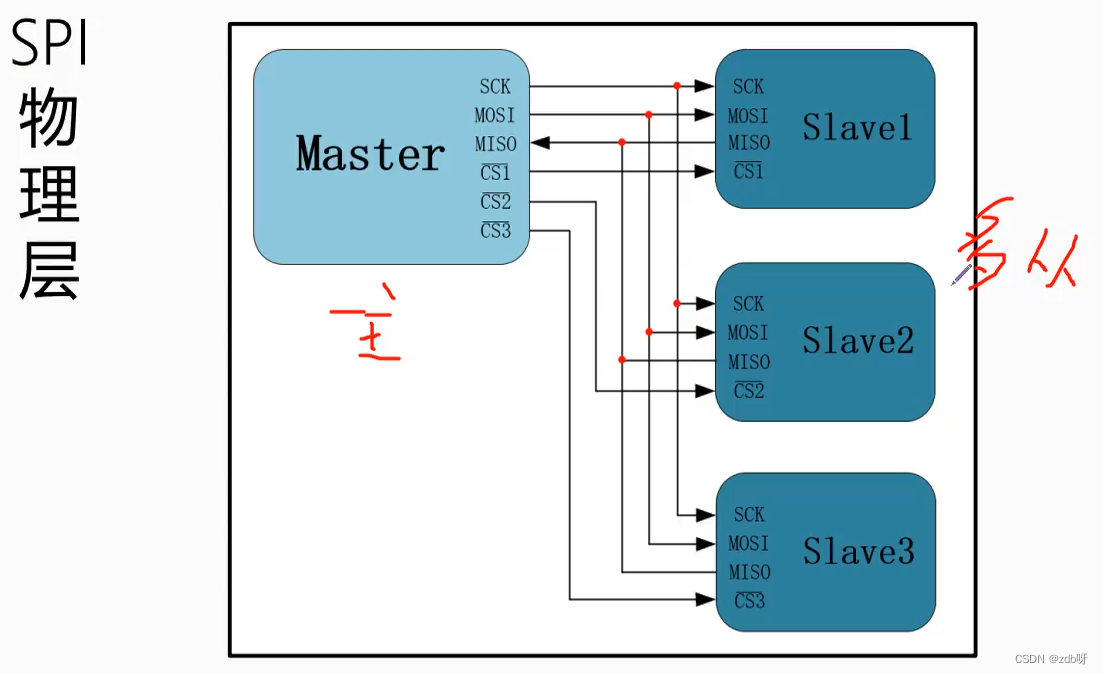
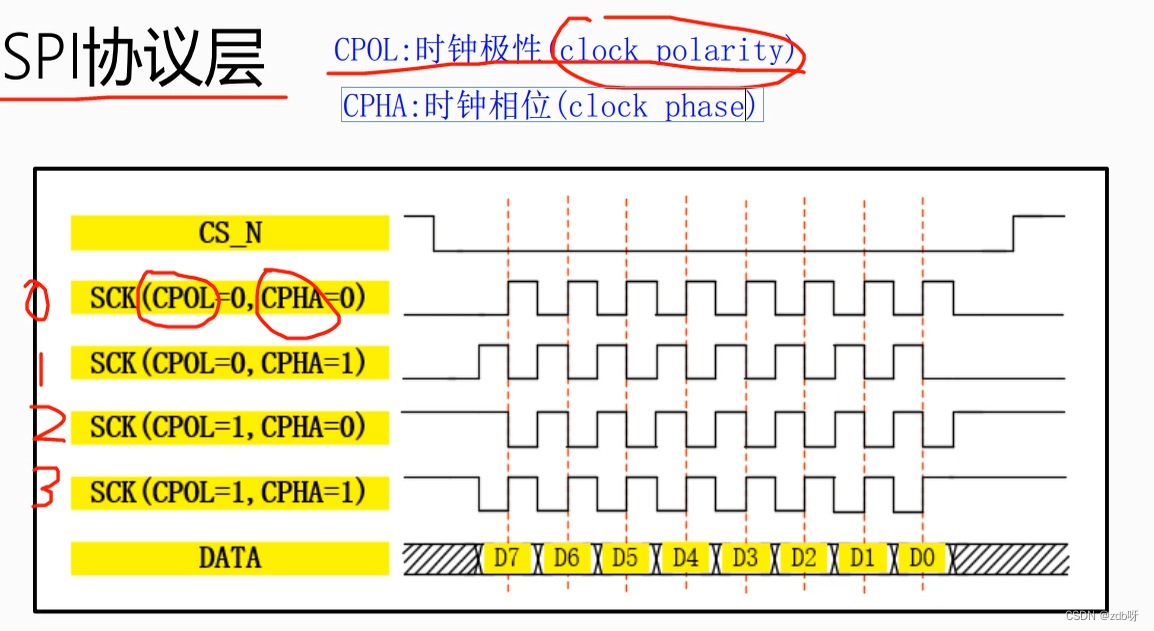
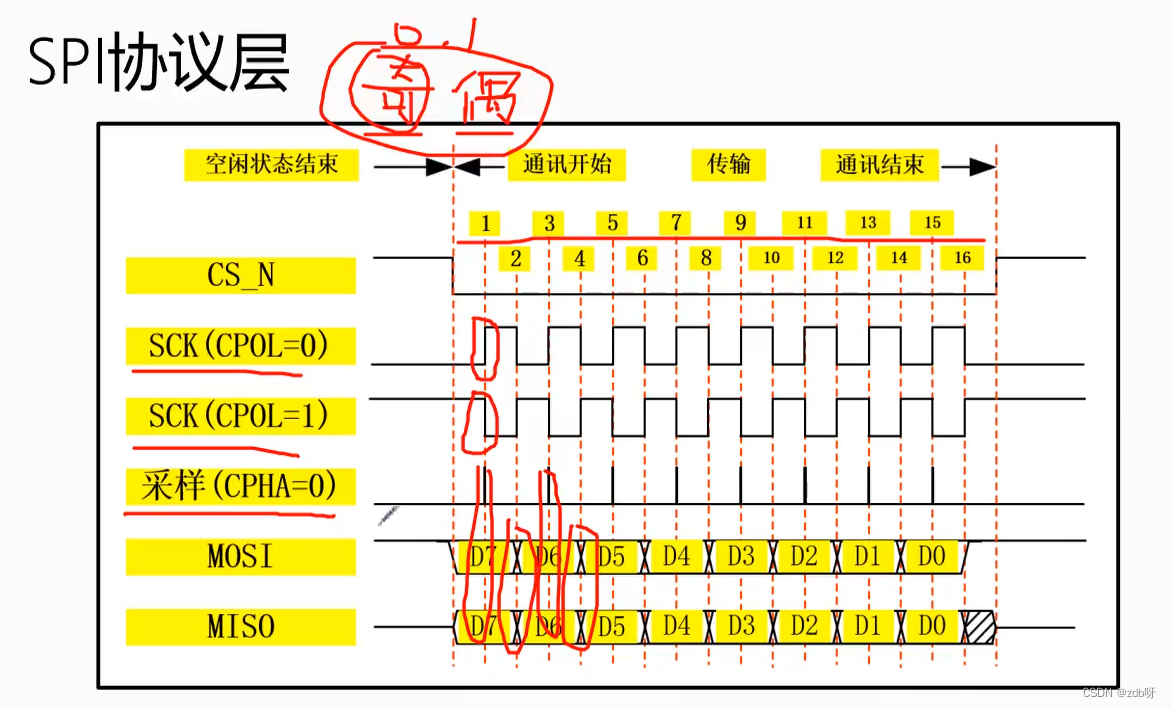

1. Flash全擦除实验
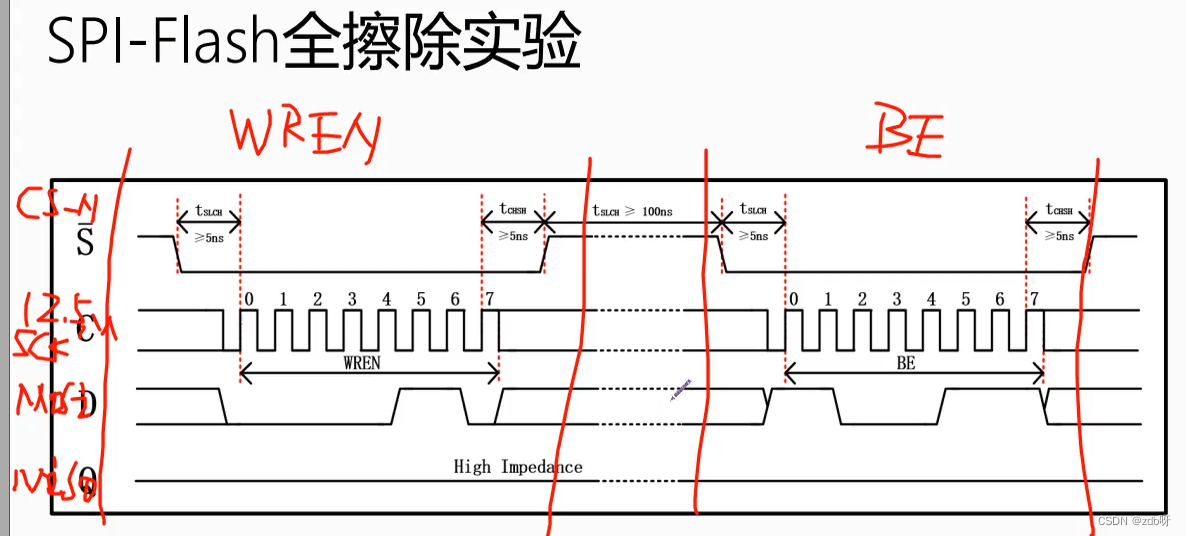



key_filter
`timescale 1ns/1ns
module key_filter
#(
parameter CNT_MAX = 20'd999_999 //计数器计数最大值
)
(
input wire sys_clk , //系统时钟50Mhz
input wire sys_rst_n , //全局复位
input wire key_in , //按键输入信号
output reg key_flag //key_flag为1时表示消抖后检测到按键被按下
//key_flag为0时表示没有检测到按键被按下
);
//reg define
reg [19:0] cnt_20ms ; //计数器
//cnt_20ms:如果时钟的上升沿检测到外部按键输入的值为低电平时,计数器开始计数
always@(posedge sys_clk or negedge sys_rst_n)
if(sys_rst_n == 1'b0)
cnt_20ms <= 20'b0;
else if(key_in == 1'b1)
cnt_20ms <= 20'b0;
else if(cnt_20ms == CNT_MAX && key_in == 1'b0)
cnt_20ms <= cnt_20ms;
else
cnt_20ms <= cnt_20ms + 1'b1;
//key_flag:当计数满20ms后产生按键有效标志位
//且key_flag在999_999时拉高,维持一个时钟的高电平
always@(posedge sys_clk or negedge sys_rst_n)
if(sys_rst_n == 1'b0)
key_flag <= 1'b0;
else if(cnt_20ms == CNT_MAX - 1'b1)
key_flag <= 1'b1;
else
key_flag <= 1'b0;
endmodule
flash_be_ctrl
`timescale 1ns/1ns
module flash_be_ctrl
(
input wire sys_clk , //系统时钟,频率50MHz
input wire sys_rst_n , //复位信号,低电平有效
input wire key , //按键输入信号
output reg cs_n , //片选信号
output reg sck , //串行时钟
output reg mosi //主输出从输入数据
);
//parameter define
parameter IDLE = 4'b0001 , //初始状态
WR_EN = 4'b0010 , //写状态
DELAY = 4'b0100 , //等待状态
BE = 4'b1000 ; //全擦除状态
parameter WR_EN_INST = 8'b0000_0110, //写使能指令
BE_INST = 8'b1100_0111; //全擦除指令
//reg define
reg [2:0] cnt_byte; //字节计数器
reg [3:0] state ; //状态机状态
reg [4:0] cnt_clk ; //系统时钟计数器
reg [1:0] cnt_sck ; //串行时钟计数器
reg [2:0] cnt_bit ; //比特计数器
//cnt_clk:系统时钟计数器,用以记录单个字节
always@(posedge sys_clk or negedge sys_rst_n)
if(sys_rst_n == 1'b0)
cnt_clk <= 5'd0;
else if(state != IDLE)
cnt_clk <= cnt_clk + 1'b1;
//cnt_byte:记录输出字节个数和等待时间
always@(posedge sys_clk or negedge sys_rst_n)
if(sys_rst_n == 1'b0)
cnt_byte <= 3'd0;
else if((cnt_clk == 5'd31) && (cnt_byte == 3'd6))
cnt_byte <= 3'd0;
else if(cnt_clk == 31)
cnt_byte <= cnt_byte + 1'b1;
//cnt_sck:串行时钟计数器,用以生成串行时钟
always@(posedge sys_clk or negedge sys_rst_n)
if(sys_rst_n == 1'b0)
cnt_sck <= 2'd0;
else if((state == WR_EN) && (cnt_byte == 1'b1))
cnt_sck <= cnt_sck + 1'b1;
else if((state == BE) && (cnt_byte == 3'd5))
cnt_sck <= cnt_sck + 1'b1;
//cs_n:片选信号
always@(posedge sys_clk or negedge sys_rst_n)
if(sys_rst_n == 1'b0)
cs_n <= 1'b1;
else if(key == 1'b1)
cs_n <= 1'b0;
else if((cnt_byte == 3'd2) && (cnt_clk == 5'd31) && (state == WR_EN))
cs_n <= 1'b1;
else if((cnt_byte == 3'd3) && (cnt_clk == 5'd31) && (state == DELAY))
cs_n <= 1'b0;
else if((cnt_byte == 3'd6) && (cnt_clk == 5'd31) && (state == BE))
cs_n <= 1'b1;
//sck:输出串行时钟
always@(posedge sys_clk or negedge sys_rst_n)
if(sys_rst_n == 1'b0)
sck <= 1'b0;
else if(cnt_sck == 2'd0)
sck <= 1'b0;
else if(cnt_sck == 2'd2)
sck <= 1'b1;
//cnt_bit:高低位对调,控制mosi输出
always@(posedge sys_clk or negedge sys_rst_n)
if(sys_rst_n == 1'b0)
cnt_bit <= 3'd0;
else if(cnt_sck == 2'd2)
cnt_bit <= cnt_bit + 1'b1;
//state:两段式状态机第一段,状态跳转
always@(posedge sys_clk or negedge sys_rst_n)
if(sys_rst_n == 1'b0)
state <= IDLE;
else
case(state)
IDLE: if(key == 1'b1)
state <= WR_EN;
WR_EN: if((cnt_byte == 3'd2) && (cnt_clk == 5'd31))
state <= DELAY;
DELAY: if((cnt_byte == 3'd3) && (cnt_clk == 5'd31))
state <= BE;
BE: if((cnt_byte == 3'd6) && (cnt_clk == 5'd31))
state <= IDLE;
default: state <= IDLE;
endcase
//mosi:两段式状态机第二段,逻辑输出
always@(posedge sys_clk or negedge sys_rst_n)
if(sys_rst_n == 1'b0)
mosi <= 1'b0;
else if((state == WR_EN) && (cnt_byte == 3'd2))
mosi <= 1'b0;
else if((state == BE) && (cnt_byte == 3'd6))
mosi <= 1'b0;
else if((state == WR_EN) && (cnt_byte == 3'd1) && (cnt_sck == 5'd0))
mosi <= WR_EN_INST[7 - cnt_bit]; //写使能指令
else if((state == BE) && (cnt_byte == 3'd5) && (cnt_sck == 5'd0))
mosi <= BE_INST[7 - cnt_bit]; //全擦除指令
endmodule
spi_flash_be
`timescale 1ns/1ns
module spi_flash_be
(
input wire sys_clk , //系统时钟,频率50MHz
input wire sys_rst_n , //复位信号,低电平有效
input wire pi_key , //按键输入信号
output wire cs_n , //片选信号
output wire sck , //串行时钟
output wire mosi //主输出从输入数据
);
//parameter define
parameter CNT_MAX = 20'd999_999; //计数器计数最大值
//wire define
wire po_key ;
//------------- key_filter_inst -------------
key_filter
#(
.CNT_MAX (CNT_MAX ) //计数器计数最大值
)
key_filter_inst
(
.sys_clk (sys_clk ), //系统时钟,频率50MHz
.sys_rst_n (sys_rst_n ), //复位信号,低电平有效
.key_in (pi_key ), //按键输入信号
.key_flag (po_key ) //消抖后信号
);
//------------- flash_be_ctrl_inst -------------
flash_be_ctrl flash_be_ctrl_inst
(
.sys_clk (sys_clk ), //系统时钟,频率50MHz
.sys_rst_n (sys_rst_n ), //复位信号,低电平有效
.key (po_key ), //按键输入信号
.sck (sck ), //片选信号
.cs_n (cs_n ), //串行时钟
.mosi (mosi ) //主输出从输入数据
);
endmodule
tb_flash_be_ctrl
`timescale 1ns/1ns
module tb_flash_be_ctrl();
//wire define
wire cs_n ; //Flash片选信号
wire sck ; //Flash串行时钟
wire mosi ; //Flash主输出从输入信号
//reg define
reg sys_clk ; //模拟时钟信号
reg sys_rst_n ; //模拟复位信号
reg key ; //模拟全擦除触发信号
//时钟、复位信号、模拟按键信号
initial
begin
sys_clk = 1'b1;
sys_rst_n <= 1'b0;
key <= 1'b0;
#100
sys_rst_n <= 1'b1;
#1000
key <= 1'b1;
#20
key <= 1'b0;
end
always #10 sys_clk <= ~sys_clk; //模拟时钟,频率50MHz
//写入Flash仿真模型初始值(全F)
defparam memory.mem_access.initfile = "initmemory.txt";
//------------- flash_be_ctrl_inst -------------
flash_be_ctrl flash_be_ctrl_inst
(
.sys_clk (sys_clk ), //输入系统时钟,频率50MHz,1bit
.sys_rst_n (sys_rst_n ), //输入复位信号,低电平有效,1bit
.key (key ), //按键输入信号,1bit
.sck (sck ), //输出串行时钟,1bit
.cs_n (cs_n ), //输出片选信号,1bit
.mosi (mosi ) //输出主输出从输入数据,1bit
);
//------------- memory -------------
m25p16 memory
(
.c (sck ), //输入串行时钟,频率12.5Mhz,1bit
.data_in (mosi ), //输入串行指令或数据,1bit
.s (cs_n ), //输入片选信号,1bit
.w (1'b1 ), //输入写保护信号,低有效,1bit
.hold (1'b1 ), //输入hold信号,低有效,1bit
.data_out ( ) //输出串行数据
);
endmodule
tb_spi_flash_be
`timescale 1ns/1ns
module tb_spi_flash_be();
//wire define
wire cs_n;
wire sck ;
wire mosi ;
//reg define
reg clk ;
reg rst_n ;
reg key ;
//时钟、复位信号、模拟按键信号
initial
begin
clk = 0;
rst_n <= 0;
key <= 0;
#100
rst_n <= 1;
#1000
key <= 1;
#20
key <= 0;
end
always #10 clk <= ~clk;
defparam memory.mem_access.initfile = "initmemory.txt";
//-------------spi_flash_erase-------------
spi_flash_be spi_flash_be_inst
(
.sys_clk (clk ), //系统时钟,频率50MHz
.sys_rst_n (rst_n ), //复位信号,低电平有效
.pi_key (key ), //按键输入信号
.sck (sck ), //串行时钟
.cs_n (cs_n ), //片选信号
.mosi (mosi ) //主输出从输入数据
);
m25p16 memory
(
.c (sck ), //输入串行时钟,频率12.5Mhz,1bit
.data_in (mosi ), //输入串行指令或数据,1bit
.s (cs_n ), //输入片选信号,1bit
.w (1'b1 ), //输入写保护信号,低有效,1bit
.hold (1'b1 ), //输入hold信号,低有效,1bit
.data_out ( ) //输出串行数据
);
endmodule
2. Flash扇区擦除实验
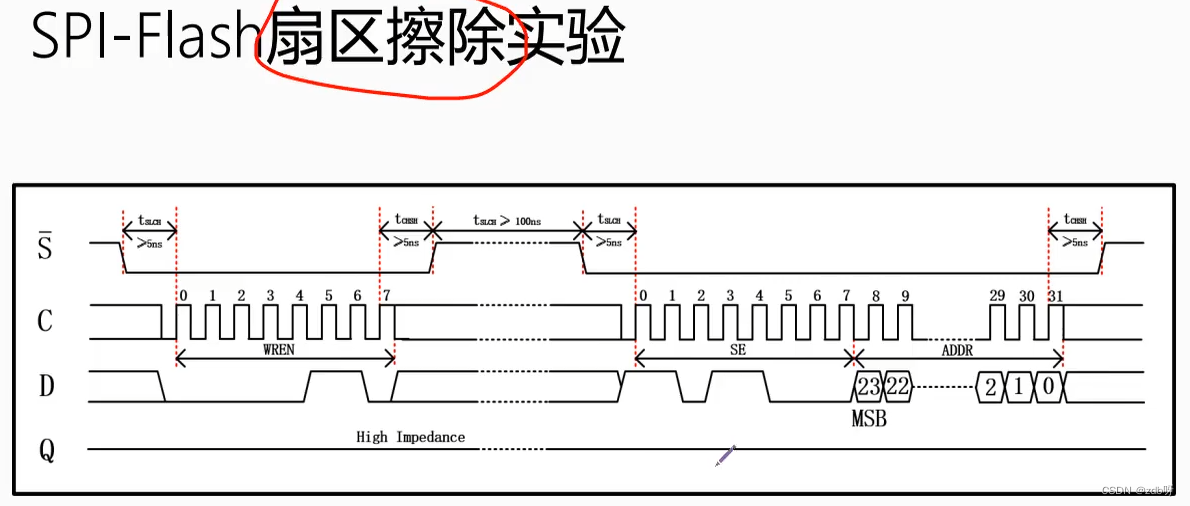

key_filter
`timescale 1ns/1ns
module key_filter
#(
parameter CNT_MAX = 20'd999_999 //计数器计数最大值
)
(
input wire sys_clk , //系统时钟50Mhz
input wire sys_rst_n , //全局复位
input wire key_in , //按键输入信号
output reg key_flag //key_flag为1时表示消抖后检测到按键被按下
//key_flag为0时表示没有检测到按键被按下
);
//reg define
reg [19:0] cnt_20ms ; //计数器
//cnt_20ms:如果时钟的上升沿检测到外部按键输入的值为低电平时,计数器开始计数
always@(posedge sys_clk or negedge sys_rst_n)
if(sys_rst_n == 1'b0)
cnt_20ms <= 20'b0;
else if(key_in == 1'b1)
cnt_20ms <= 20'b0;
else if(cnt_20ms == CNT_MAX && key_in == 1'b0)
cnt_20ms <= cnt_20ms;
else
cnt_20ms <= cnt_20ms + 1'b1;
//key_flag:当计数满20ms后产生按键有效标志位
//且key_flag在999_999时拉高,维持一个时钟的高电平
always@(posedge sys_clk or negedge sys_rst_n)
if(sys_rst_n == 1'b0)
key_flag <= 1'b0;
else if(cnt_20ms == CNT_MAX - 1'b1)
key_flag <= 1'b1;
else
key_flag <= 1'b0;
endmodule
flash_se_ctrl
`timescale 1ns/1ns
module flash_se_ctrl
(
input wire sys_clk , //系统时钟,频率50MHz
input wire sys_rst_n , //复位信号,低电平有效
input wire key , //按键输入信号
output reg cs_n , //片选信号
output reg sck , //串行时钟
output reg mosi //主输出从输入数据
);
//parameter define
parameter IDLE = 4'b0001 , //初始状态
WR_EN = 4'b0010 , //写状态
DELAY = 4'b0100 , //等待状态
SE = 4'b1000 ; //扇区擦除状态
parameter WR_EN_INST = 8'b0000_0110, //写使能指令
SE_INST = 8'b1101_1000; //扇区擦除指令
parameter SECTOR_ADDR = 8'b0000_0000, //扇区地址
PAGE_ADDR = 8'b0000_0100, //页地址
BYTE_ADDR = 8'b0010_0101; //字节地址
//reg define
reg [3:0] cnt_byte; //字节计数器
reg [3:0] state ; //状态机状态
reg [4:0] cnt_clk ; //系统时钟计数器
reg [1:0] cnt_sck ; //串行时钟计数器
reg [2:0] cnt_bit ; //比特计数器
//cnt_clk:系统时钟计数器,用以记录单个字节
always@(posedge sys_clk or negedge sys_rst_n)
if(sys_rst_n == 1'b0)
cnt_clk <= 5'd0;
else if(state != IDLE)
cnt_clk <= cnt_clk + 1'b1;
//cnt_byte:记录输出字节个数和等待时间
always@(posedge sys_clk or negedge sys_rst_n)
if(sys_rst_n == 1'b0)
cnt_byte <= 4'd0;
else if((cnt_clk == 5'd31) && (cnt_byte == 4'd9))
cnt_byte <= 4'd0;
else if(cnt_clk == 31)
cnt_byte <= cnt_byte + 1'b1;
//cnt_sck:串行时钟计数器,用以生成串行时钟
always@(posedge sys_clk or negedge sys_rst_n)
if(sys_rst_n == 1'b0)
cnt_sck <= 2'd0;
else if((state == WR_EN) && (cnt_byte == 1'b1))
cnt_sck <= cnt_sck + 1'b1;
else if((state == SE) && (cnt_byte >= 4'd5) && (cnt_byte <= 4'd8))
cnt_sck <= cnt_sck + 1'b1;
//cs_n:片选信号
always@(posedge sys_clk or negedge sys_rst_n)
if(sys_rst_n == 1'b0)
cs_n <= 1'b1;
else if(key == 1'b1)
cs_n <= 1'b0;
else if((cnt_byte == 4'd2) && (cnt_clk == 5'd31) && (state == WR_EN))
cs_n <= 1'b1;
else if((cnt_byte == 4'd3) && (cnt_clk == 5'd31) && (state == DELAY))
cs_n <= 1'b0;
else if((cnt_byte == 4'd9) && (cnt_clk == 5'd31) && (state == SE))
cs_n <= 1'b1;
//sck:输出串行时钟
always@(posedge sys_clk or negedge sys_rst_n)
if(sys_rst_n == 1'b0)
sck <= 1'b0;
else if(cnt_sck == 2'd0)
sck <= 1'b0;
else if(cnt_sck == 2'd2)
sck <= 1'b1;
//cnt_bit:高低位对调,控制mosi输出
always@(posedge sys_clk or negedge sys_rst_n)
if(sys_rst_n == 1'b0)
cnt_bit <= 3'd0;
else if(cnt_sck == 2'd2)
cnt_bit <= cnt_bit + 1'b1;
//state:两段式状态机第一段,状态跳转
always@(posedge sys_clk or negedge sys_rst_n)
if(sys_rst_n == 1'b0)
state <= IDLE;
else
case(state)
IDLE: if(key == 1'b1)
state <= WR_EN;
WR_EN: if((cnt_byte == 4'd2) && (cnt_clk == 5'd31))
state <= DELAY;
DELAY: if((cnt_byte == 4'd3) && (cnt_clk == 5'd31))
state <= SE;
SE: if((cnt_byte == 4'd9) && (cnt_clk == 5'd31))
state <= IDLE;
default: state <= IDLE;
endcase
//mosi:两段式状态机第二段,逻辑输出
always@(posedge sys_clk or negedge sys_rst_n)
if(sys_rst_n == 1'b0)
mosi <= 1'b0;
else if((state == WR_EN) && (cnt_byte == 4'd2))
mosi <= 1'b0;
else if((state == SE) && (cnt_byte == 4'd9))
mosi <= 1'b0;
else if((state == WR_EN) && (cnt_byte == 4'd1) && (cnt_sck == 5'd0))
mosi <= WR_EN_INST[7 - cnt_bit]; //写使能指令
else if((state == SE) && (cnt_byte == 4'd5) && (cnt_sck == 5'd0))
mosi <= SE_INST[7 - cnt_bit]; //扇区擦除指令
else if((state == SE) && (cnt_byte == 4'd6) && (cnt_sck == 5'd0))
mosi <= SECTOR_ADDR[7 - cnt_bit]; //扇区地址
else if((state == SE) && (cnt_byte == 4'd7) && (cnt_sck == 5'd0))
mosi <= PAGE_ADDR[7 - cnt_bit]; //页地址
else if((state == SE) && (cnt_byte == 4'd8) && (cnt_sck == 5'd0))
mosi <= BYTE_ADDR[7 - cnt_bit]; //字节地址
endmodule
spi_flash_se
`timescale 1ns/1ns
module spi_flash_se
(
input wire sys_clk , //系统时钟,频率50MHz
input wire sys_rst_n , //复位信号,低电平有效
input wire pi_key , //按键输入信号
output wire cs_n , //片选信号
output wire sck , //串行时钟
output wire mosi //主输出从输入数据
);
//parameter define
parameter CNT_MAX = 20'd999_999; //计数器计数最大值
//wire define
wire po_key ;
//------------- key_filter_inst -------------
key_filter
#(
.CNT_MAX (CNT_MAX ) //计数器计数最大值
)
key_filter_inst
(
.sys_clk (sys_clk ), //系统时钟,频率50MHz
.sys_rst_n (sys_rst_n ), //复位信号,低电平有效
.key_in (pi_key ), //按键输入信号
.key_flag (po_key ) //消抖后信号
);
//------------- flash_se_ctrl_inst -------------
flash_se_ctrl flash_se_ctrl_inst
(
.sys_clk (sys_clk ), //系统时钟,频率50MHz
.sys_rst_n (sys_rst_n ), //复位信号,低电平有效
.key (po_key ), //按键输入信号
.sck (sck ), //片选信号
.cs_n (cs_n ), //串行时钟
.mosi (mosi ) //主输出从输入数据
);
endmodule
3. 数据读操作
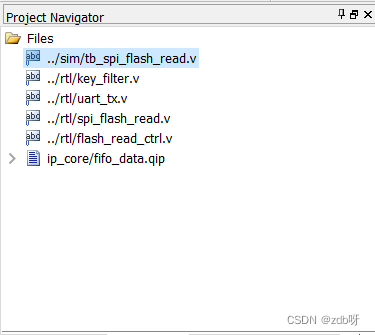
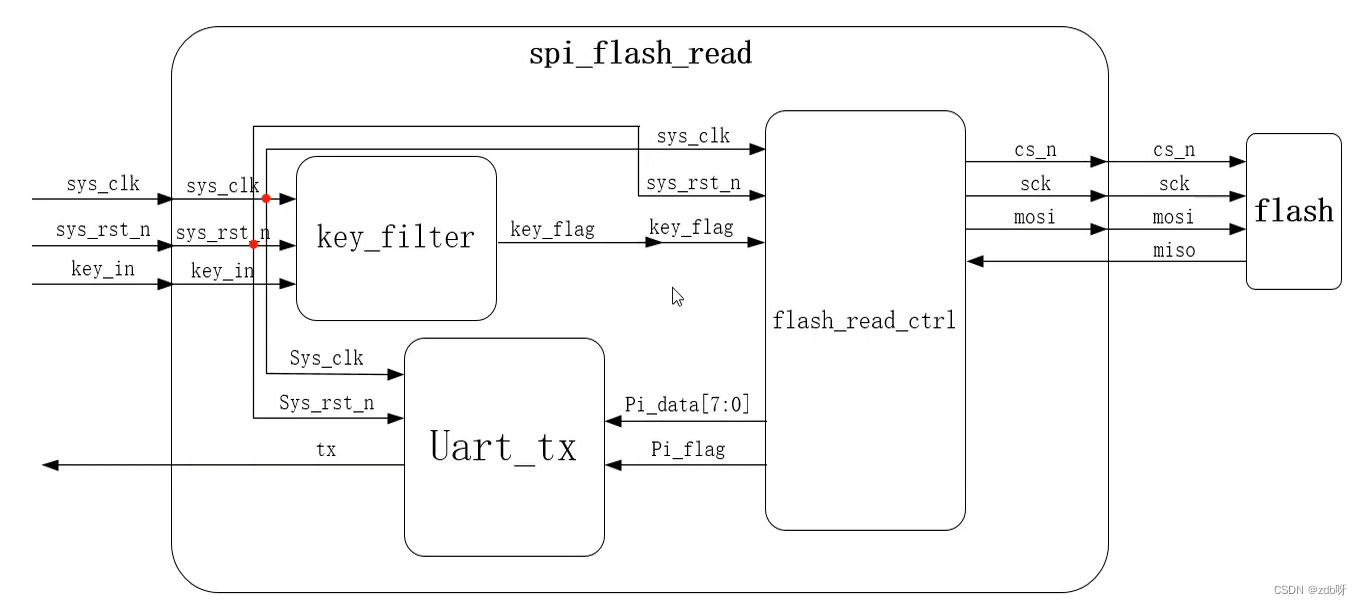

key_filter
`timescale 1ns/1ns
module key_filter
#(
parameter CNT_MAX = 20'd999_999 //计数器计数最大值
)
(
input wire sys_clk , //系统时钟50Mhz
input wire sys_rst_n , //全局复位
input wire key_in , //按键输入信号
output reg key_flag //key_flag为1时表示消抖后检测到按键被按下
//key_flag为0时表示没有检测到按键被按下
);
//reg define
reg [19:0] cnt_20ms ; //计数器
//cnt_20ms:如果时钟的上升沿检测到外部按键输入的值为低电平时,计数器开始计数
always@(posedge sys_clk or negedge sys_rst_n)
if(sys_rst_n == 1'b0)
cnt_20ms <= 20'b0;
else if(key_in == 1'b1)
cnt_20ms <= 20'b0;
else if(cnt_20ms == CNT_MAX && key_in == 1'b0)
cnt_20ms <= cnt_20ms;
else
cnt_20ms <= cnt_20ms + 1'b1;
//key_flag:当计数满20ms后产生按键有效标志位
//且key_flag在999_999时拉高,维持一个时钟的高电平
always@(posedge sys_clk or negedge sys_rst_n)
if(sys_rst_n == 1'b0)
key_flag <= 1'b0;
else if(cnt_20ms == CNT_MAX - 1'b1)
key_flag <= 1'b1;
else
key_flag <= 1'b0;
endmodule
uart_tx
`timescale 1ns/1ns
module uart_tx
#(
parameter UART_BPS = 'd9600, //串口波特率
parameter CLK_FREQ = 'd50_000_000 //时钟频率
)
(
input wire sys_clk , //系统时钟50MHz
input wire sys_rst_n , //全局复位
input wire [7:0] pi_data , //模块输入的8bit数据
input wire pi_flag , //并行数据有效标志信号
output reg tx //串转并后的1bit数据
);
//localparam define
localparam BAUD_CNT_MAX = CLK_FREQ/UART_BPS ;
//reg define
reg [12:0] baud_cnt;
reg bit_flag;
reg [3:0] bit_cnt ;
reg work_en ;
//work_en:接收数据工作使能信号
always@(posedge sys_clk or negedge sys_rst_n)
if(sys_rst_n == 1'b0)
work_en <= 1'b0;
else if(pi_flag == 1'b1)
work_en <= 1'b1;
else if((bit_flag == 1'b1) && (bit_cnt == 4'd9))
work_en <= 1'b0;
//baud_cnt:波特率计数器计数,从0计数到BAUD_CNT_MAX - 1
always@(posedge sys_clk or negedge sys_rst_n)
if(sys_rst_n == 1'b0)
baud_cnt <= 13'b0;
else if((baud_cnt == BAUD_CNT_MAX - 1) || (work_en == 1'b0))
baud_cnt <= 13'b0;
else if(work_en == 1'b1)
baud_cnt <= baud_cnt + 1'b1;
//bit_flag:当baud_cnt计数器计数到1时让bit_flag拉高一个时钟的高电平
always@(posedge sys_clk or negedge sys_rst_n)
if(sys_rst_n == 1'b0)
bit_flag <= 1'b0;
else if(baud_cnt == 13'd1)
bit_flag <= 1'b1;
else
bit_flag <= 1'b0;
//bit_cnt:数据位数个数计数,10个有效数据(含起始位和停止位)到来后计数器清零
always@(posedge sys_clk or negedge sys_rst_n)
if(sys_rst_n == 1'b0)
bit_cnt <= 4'b0;
else if((bit_flag == 1'b1) && (bit_cnt == 4'd9))
bit_cnt <= 4'b0;
else if((bit_flag == 1'b1) && (work_en == 1'b1))
bit_cnt <= bit_cnt + 1'b1;
//tx:输出数据在满足rs232协议(起始位为0,停止位为1)的情况下一位一位输出
always@(posedge sys_clk or negedge sys_rst_n)
if(sys_rst_n == 1'b0)
tx <= 1'b1; //空闲状态时为高电平
else if(bit_flag == 1'b1)
case(bit_cnt)
0 : tx <= 1'b0;
1 : tx <= pi_data[0];
2 : tx <= pi_data[1];
3 : tx <= pi_data[2];
4 : tx <= pi_data[3];
5 : tx <= pi_data[4];
6 : tx <= pi_data[5];
7 : tx <= pi_data[6];
8 : tx <= pi_data[7];
9 : tx <= 1'b1;
default : tx <= 1'b1;
endcase
endmodule
flash_read_ctrl
`timescale 1ns/1ns
module flash_read_ctrl(
input wire sys_clk , //系统时钟,频率50MHz
input wire sys_rst_n , //复位信号,低电平有效
input wire key , //按键输入信号
input wire miso , //读出flash数据
output reg sck , //串行时钟
output reg cs_n , //片选信号
output reg mosi , //主输出从输入数据
output reg tx_flag , //输出数据标志信号
output wire [7:0] tx_data //输出数据
);
//parameter define
parameter IDLE = 3'b001 , //初始状态
READ = 3'b010 , //数据读状态
SEND = 3'b100 ; //数据发送状态
parameter READ_INST = 8'b0000_0011; //读指令
parameter NUM_DATA = 16'd100 ; //读出数据个数
parameter SECTOR_ADDR = 8'b0000_0000, //扇区地址
PAGE_ADDR = 8'b0000_0100, //页地址
BYTE_ADDR = 8'b0010_0101; //字节地址
parameter CNT_WAIT_MAX= 16'd6_00_00 ;
//wire define
wire [7:0] fifo_data_num ; //fifo内数据个数
//reg define
reg [4:0] cnt_clk ; //系统时钟计数器
reg [2:0] state ; //状态机状态
reg [15:0] cnt_byte ; //字节计数器
reg [1:0] cnt_sck ; //串行时钟计数器
reg [2:0] cnt_bit ; //比特计数器
reg miso_flag ; //miso提取标志信号
reg [7:0] data ; //拼接数据
reg po_flag_reg ; //输出数据标志信号
reg po_flag ; //输出数据
reg [7:0] po_data ; //输出数据
reg fifo_read_valid ; //fifo读有效信号
reg [15:0] cnt_wait ; //等待计数器
reg fifo_read_en ; //fifo读使能
reg [7:0] read_data_num ; //读出fifo数据个数
//cnt_clk:系统时钟计数器,用以记录单个字节
always@(posedge sys_clk or negedge sys_rst_n)
if(sys_rst_n == 1'b0)
cnt_clk <= 5'd0;
else if(state == READ)
cnt_clk <= cnt_clk + 1'b1;
//cnt_byte:记录输出字节个数和等待时间
always@(posedge sys_clk or negedge sys_rst_n)
if(sys_rst_n == 1'b0)
cnt_byte <= 16'd0;
else if((cnt_clk == 5'd31) && (cnt_byte == NUM_DATA + 16'd3))
cnt_byte <= 16'd0;
else if(cnt_clk == 5'd31)
cnt_byte <= cnt_byte + 1'b1;
//cnt_sck:串行时钟计数器,用以生成串行时钟
always@(posedge sys_clk or negedge sys_rst_n)
if(sys_rst_n == 1'b0)
cnt_sck <= 2'd0;
else if(state == READ)
cnt_sck <= cnt_sck + 1'b1;
//cs_n:片选信号
always@(posedge sys_clk or negedge sys_rst_n)
if(sys_rst_n == 1'b0)
cs_n <= 1'b1;
else if(key == 1'b1)
cs_n <= 1'b0;
else if((cnt_byte == NUM_DATA + 16'd3) && (cnt_clk == 5'd31) && (state == READ))
cs_n <= 1'b1;
//sck:输出串行时钟
always@(posedge sys_clk or negedge sys_rst_n)
if(sys_rst_n == 1'b0)
sck <= 1'b0;
else if(cnt_sck == 2'd0)
sck <= 1'b0;
else if(cnt_sck == 2'd2)
sck <= 1'b1;
//cnt_bit:高低位对调,控制mosi输出
always@(posedge sys_clk or negedge sys_rst_n)
if(sys_rst_n == 1'b0)
cnt_bit <= 3'd0;
else if(cnt_sck == 2'd2)
cnt_bit <= cnt_bit + 1'b1;
//state:两段式状态机第一段,状态跳转
always@(posedge sys_clk or negedge sys_rst_n)
if(sys_rst_n == 1'b0)
state <= IDLE;
else
case(state)
IDLE: if(key == 1'b1)
state <= READ;
READ: if((cnt_byte == NUM_DATA + 16'd3) && (cnt_clk == 5'd31))
state <= SEND;
SEND: if((read_data_num == NUM_DATA)
&& ((cnt_wait == (CNT_WAIT_MAX - 1'b1))))
state <= IDLE;
default: state <= IDLE;
endcase
//mosi:两段式状态机第二段,逻辑输出
always@(posedge sys_clk or negedge sys_rst_n)
if(sys_rst_n == 1'b0)
mosi <= 1'b0;
else if((state == READ) && (cnt_byte>= 16'd4))
mosi <= 1'b0;
else if((state == READ) && (cnt_byte == 16'd0) && (cnt_sck == 2'd0))
mosi <= READ_INST[7 - cnt_bit]; //读指令
else if((state == READ) && (cnt_byte == 16'd1) && (cnt_sck == 2'd0))
mosi <= SECTOR_ADDR[7 - cnt_bit]; //扇区地址
else if((state == READ) && (cnt_byte == 16'd2) && (cnt_sck == 2'd0))
mosi <= PAGE_ADDR[7 - cnt_bit]; //页地址
else if((state == READ) && (cnt_byte == 16'd3) && (cnt_sck == 2'd0))
mosi <= BYTE_ADDR[7 - cnt_bit]; //字节地址
//miso_flag:miso提取标志信号
always@(posedge sys_clk or negedge sys_rst_n)
if(sys_rst_n == 1'b0)
miso_flag <= 1'b0;
else if((cnt_byte >= 16'd4) && (cnt_sck == 2'd1))
miso_flag <= 1'b1;
else
miso_flag <= 1'b0;
//data:拼接数据
always@(posedge sys_clk or negedge sys_rst_n)
if(sys_rst_n == 1'b0)
data <= 8'd0;
else if(miso_flag == 1'b1)
data <= {data[6:0],miso};
//po_flag_reg:输出数据标志信号
always@(posedge sys_clk or negedge sys_rst_n)
if(sys_rst_n == 1'b0)
po_flag_reg <= 1'b0;
else if((cnt_bit == 3'd7) && (miso_flag == 1'b1))
po_flag_reg <= 1'b1;
else
po_flag_reg <= 1'b0;
//po_flag:输出数据标志信号
always@(posedge sys_clk or negedge sys_rst_n)
if(sys_rst_n == 1'b0)
po_flag <= 1'b0;
else
po_flag <= po_flag_reg;
//po_data:输出数据
always@(posedge sys_clk or negedge sys_rst_n)
if(sys_rst_n == 1'b0)
po_data <= 8'd0;
else if(po_flag_reg == 1'b1)
po_data <= data;
else
po_data <= po_data;
//fifo_read_valid:fifo读有效信号
always@(posedge sys_clk or negedge sys_rst_n)
if(sys_rst_n == 1'b0)
fifo_read_valid <= 1'b0;
else if((read_data_num == NUM_DATA)
&& ((cnt_wait == (CNT_WAIT_MAX - 1'b1))))
fifo_read_valid <= 1'b0;
else if(fifo_data_num == NUM_DATA)
fifo_read_valid <= 1'b1;
//cnt_wait:两数据读取时间间隔
always@(posedge sys_clk or negedge sys_rst_n)
if(sys_rst_n == 1'b0)
cnt_wait <= 16'd0;
else if(fifo_read_valid == 1'b0)
cnt_wait <= 16'd0;
else if(cnt_wait == (CNT_WAIT_MAX - 1'b1))
cnt_wait <= 16'd0;
else if(fifo_read_valid == 1'b1)
cnt_wait <= cnt_wait + 1'b1;
//fifo_read_en:fifo读使能信号
always@(posedge sys_clk or negedge sys_rst_n)
if(sys_rst_n == 1'b0)
fifo_read_en <= 1'b0;
else if((cnt_wait == (CNT_WAIT_MAX - 1'b1))
&& (read_data_num < NUM_DATA))
fifo_read_en <= 1'b1;
else
fifo_read_en <= 1'b0;
//read_data_num:自fifo中读出数据个数计数
always@(posedge sys_clk or negedge sys_rst_n)
if(sys_rst_n == 1'b0)
read_data_num <= 8'd0;
else if(fifo_read_valid == 1'b0)
read_data_num <= 8'd0;
else if(fifo_read_en == 1'b1)
read_data_num <= read_data_num + 1'b1;
//tx_flag
always@(posedge sys_clk or negedge sys_rst_n)
if(sys_rst_n == 1'b0)
tx_flag <= 1'b0;
else
tx_flag <= fifo_read_en;
//-------------fifo_data_inst--------------
fifo_data fifo_data_inst(
.clock (sys_clk ), //时钟信号
.data (po_data ), //写数据,8bit
.wrreq (po_flag ), //写请求
.rdreq (fifo_read_en ), //读请求
.q (tx_data ), //数据读出,8bit
.usedw (fifo_data_num) //fifo内数据个数
);
endmodule
spi_flash_read
`timescale 1ns/1ns
module spi_flash_read(
input wire sys_clk , //系统时钟,频率50MHz
input wire sys_rst_n , //复位信号,低电平有效
input wire pi_key , //按键输入信号
input wire miso , //读出flash数据
output wire cs_n , //片选信号
output wire sck , //串行时钟
output wire mosi , //主输出从输入数据
output wire tx
);
//parameter define
parameter CNT_MAX = 20'd999_999 ; //计数器计数最大值
parameter UART_BPS = 14'd9600 , //比特率
CLK_FREQ = 26'd50_000_000 ; //时钟频率
//wire define
wire po_key ; //消抖处理后的按键信号
wire tx_flag ; //输入串口发送模块数据标志信号
wire [7:0] tx_data ; //输入串口发送模块数据
//------------- key_filter_inst -------------
key_filter
#(
.CNT_MAX (CNT_MAX ) //计数器计数最大值
)
key_filter_inst
(
.sys_clk (sys_clk ), //系统时钟,频率50MHz
.sys_rst_n (sys_rst_n ), //复位信号,低电平有效
.key_in (pi_key ), //按键输入信号
.key_flag (po_key ) //消抖后信号
);
//-------------flash_read_ctrl_inst-------------
flash_read_ctrl flash_read_ctrl_inst(
.sys_clk (sys_clk ), //系统时钟,频率50MHz
.sys_rst_n (sys_rst_n ), //复位信号,低电平有效
.key (po_key ), //按键输入信号
.miso (miso ), //读出flash数据
.sck (sck ), //片选信号
.cs_n (cs_n ), //串行时钟
.mosi (mosi ), //主输出从输入数据
.tx_flag (tx_flag ), //输出数据标志信号
.tx_data (tx_data ) //输出数据
);
//-------------uart_tx_inst-------------
uart_tx
#(
.UART_BPS (UART_BPS ), //串口波特率
.CLK_FREQ (CLK_FREQ ) //时钟频率
)
uart_tx_inst(
.sys_clk (sys_clk ), //系统时钟50Mhz
.sys_rst_n (sys_rst_n), //全局复位
.pi_data (tx_data ), //并行数据
.pi_flag (tx_flag ), //并行数据有效标志信号
.tx (tx ) //串口发送数据
);
endmodule
tb_spi_flash_read
`timescale 1ns/1ns
module tb_spi_flash_read();
//wire define
wire cs_n;
wire sck ;
wire mosi;
wire miso;
wire tx ;
//reg define
reg clk ;
reg rst_n ;
reg key ;
//时钟、复位信号、模拟按键信号
initial
begin
clk = 0;
rst_n <= 0;
key <= 0;
#100
rst_n <= 1;
#1000
key <= 1;
#20
key <= 0;
end
always #10 clk <= ~clk;
defparam memory.mem_access.initfile = "initM25P16_test.txt";
defparam spi_flash_read_inst.flash_read_ctrl_inst.CNT_WAIT_MAX = 1000;
defparam spi_flash_read_inst.uart_tx_inst.CLK_FREQ = 100000;
//------------- spi_flash_read -------------
spi_flash_read spi_flash_read_inst(
.sys_clk (clk ), //input sys_clk
.sys_rst_n (rst_n ), //input sys_rst
.pi_key (key ), //input key
.miso (miso ),
.sck (sck ), //output sck
.cs_n (cs_n ), //output cs_n
.mosi (mosi ), //output mosi
.tx (tx )
);
//------------- memory -------------
m25p16 memory (
.c (sck ),
.data_in (mosi ),
.s (cs_n ),
.w (1'b1 ),
.hold (1'b1 ),
.data_out (miso )
);
endmodule
4. 数据页写操作
两种写入方式:页写,连续写
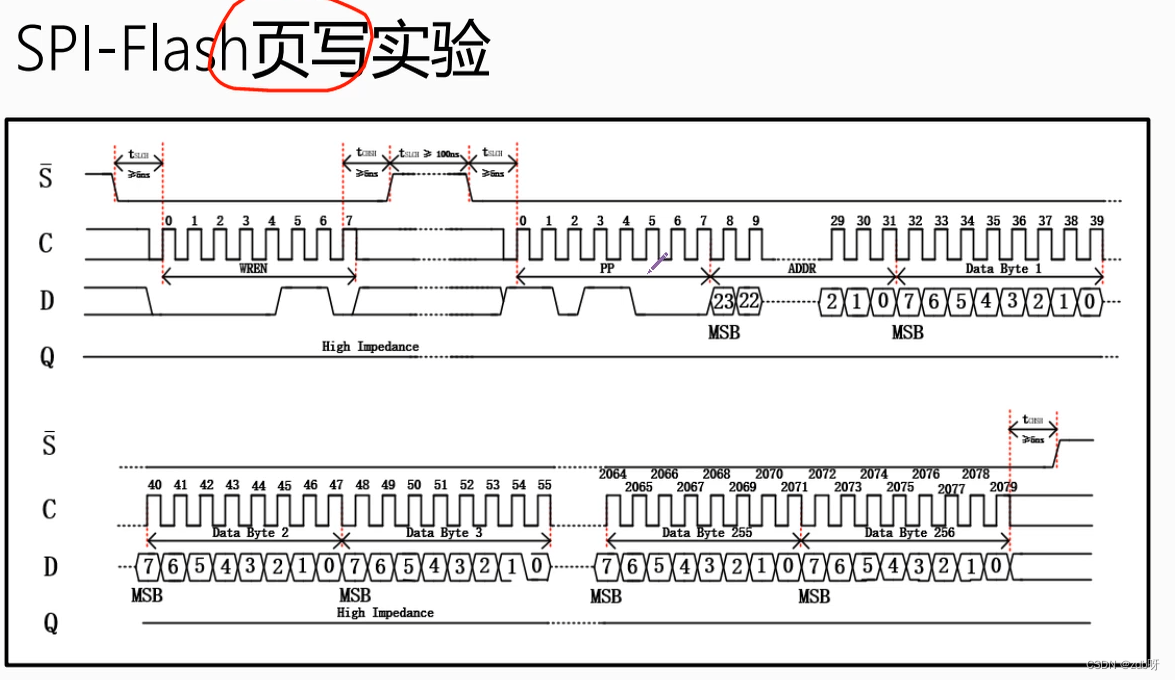

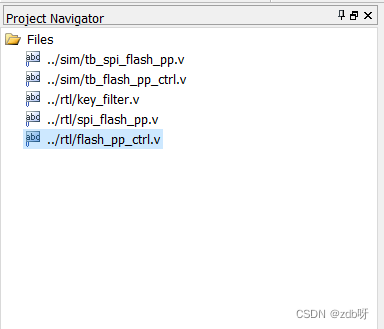
key_filter
`timescale 1ns/1ns
module key_filter
#(
parameter CNT_MAX = 20'd999_999 //计数器计数最大值
)
(
input wire sys_clk , //系统时钟50Mhz
input wire sys_rst_n , //全局复位
input wire key_in , //按键输入信号
output reg key_flag //key_flag为1时表示消抖后检测到按键被按下
//key_flag为0时表示没有检测到按键被按下
);
//reg define
reg [19:0] cnt_20ms ; //计数器
//cnt_20ms:如果时钟的上升沿检测到外部按键输入的值为低电平时,计数器开始计数
always@(posedge sys_clk or negedge sys_rst_n)
if(sys_rst_n == 1'b0)
cnt_20ms <= 20'b0;
else if(key_in == 1'b1)
cnt_20ms <= 20'b0;
else if(cnt_20ms == CNT_MAX && key_in == 1'b0)
cnt_20ms <= cnt_20ms;
else
cnt_20ms <= cnt_20ms + 1'b1;
//key_flag:当计数满20ms后产生按键有效标志位
//且key_flag在999_999时拉高,维持一个时钟的高电平
always@(posedge sys_clk or negedge sys_rst_n)
if(sys_rst_n == 1'b0)
key_flag <= 1'b0;
else if(cnt_20ms == CNT_MAX - 1'b1)
key_flag <= 1'b1;
else
key_flag <= 1'b0;
endmodule
flash_pp_ctrl
`timescale 1ns/1ns
module flash_pp_ctrl(
input wire sys_clk , //系统时钟,频率50MHz
input wire sys_rst_n , //复位信号,低电平有效
input wire key , //按键输入信号
output reg cs_n , //片选信号
output reg sck , //串行时钟
output reg mosi //主输出从输入数据
);
//parameter define
parameter IDLE = 4'b0001 , //初始状态
WR_EN = 4'b0010 , //写状态
DELAY = 4'b0100 , //等待状态
PP = 4'b1000 ; //页写状态
parameter WR_EN_INST = 8'b0000_0110, //写使能指令
PP_INST = 8'b0000_0010; //页写指令
parameter SECTOR_ADDR = 8'b0000_0000, //扇区地址
PAGE_ADDR = 8'b0000_0100, //页地址
BYTE_ADDR = 8'b0010_0101; //字节地址
parameter NUM_DATA = 8'd100 ; //页写数据个数(0-99)
//reg define
reg [7:0] cnt_byte ; //字节计数器
reg [3:0] state ; //状态机状态
reg [4:0] cnt_clk ; //系统时钟计数器
reg [1:0] cnt_sck ; //串行时钟计数器
reg [2:0] cnt_bit ; //比特计数器
reg [7:0] data ; //页写入数据
//cnt_clk:系统时钟计数器,用以记录单个字节
always@(posedge sys_clk or negedge sys_rst_n)
if(sys_rst_n == 1'b0)
cnt_clk <= 5'd0;
else if(state != IDLE)
cnt_clk <= cnt_clk + 1'b1;
//cnt_byte:记录输出字节个数和等待时间
always@(posedge sys_clk or negedge sys_rst_n)
if(sys_rst_n == 1'b0)
cnt_byte <= 8'd0;
else if((cnt_clk == 5'd31) && (cnt_byte == NUM_DATA + 8'd9))
cnt_byte <= 8'd0;
else if(cnt_clk == 5'd31)
cnt_byte <= cnt_byte + 1'b1;
//cnt_sck:串行时钟计数器,用以生成串行时钟
always@(posedge sys_clk or negedge sys_rst_n)
if(sys_rst_n == 1'b0)
cnt_sck <= 2'd0;
else if((state == WR_EN) && (cnt_byte == 8'd1))
cnt_sck <= cnt_sck + 1'b1;
else if((state == PP) && (cnt_byte >= 8'd5)
&& (cnt_byte <= NUM_DATA + 8'd9 - 1'b1))
cnt_sck <= cnt_sck + 1'b1;
//cs_n:片选信号
always@(posedge sys_clk or negedge sys_rst_n)
if(sys_rst_n == 1'b0)
cs_n <= 1'b1;
else if(key == 1'b1)
cs_n <= 1'b0;
else if((cnt_byte == 8'd2) && (cnt_clk == 5'd31) && (state == WR_EN))
cs_n <= 1'b1;
else if((cnt_byte == 8'd3) && (cnt_clk == 5'd31) && (state == DELAY))
cs_n <= 1'b0;
else if((cnt_byte == NUM_DATA + 8'd9) && (cnt_clk == 5'd31) && (state == PP))
cs_n <= 1'b1;
//sck:输出串行时钟
always@(posedge sys_clk or negedge sys_rst_n)
if(sys_rst_n == 1'b0)
sck <= 1'b0;
else if(cnt_sck == 2'd0)
sck <= 1'b0;
else if(cnt_sck == 2'd2)
sck <= 1'b1;
//cnt_bit:高低位对调,控制mosi输出
always@(posedge sys_clk or negedge sys_rst_n)
if(sys_rst_n == 1'b0)
cnt_bit <= 3'd0;
else if(cnt_sck == 2'd2)
cnt_bit <= cnt_bit + 1'b1;
//data:页写入数据
always@(posedge sys_clk or negedge sys_rst_n)
if(sys_rst_n == 1'b0)
data <= 8'd0;
else if((cnt_clk == 5'd31) && ((cnt_byte >= 8'd9)
&& (cnt_byte < NUM_DATA + 8'd9 - 1'b1)))
data <= data + 1'b1;
//state:两段式状态机第一段,状态跳转
always@(posedge sys_clk or negedge sys_rst_n)
if(sys_rst_n == 1'b0)
state <= IDLE;
else
case(state)
IDLE: if(key == 1'b1)
state <= WR_EN;
WR_EN: if((cnt_byte == 8'd2) && (cnt_clk == 5'd31))
state <= DELAY;
DELAY: if((cnt_byte == 8'd3) && (cnt_clk == 5'd31))
state <= PP;
PP: if((cnt_byte == NUM_DATA + 8'd9) && (cnt_clk == 5'd31))
state <= IDLE;
default: state <= IDLE;
endcase
//mosi:两段式状态机第二段,逻辑输出
always@(posedge sys_clk or negedge sys_rst_n)
if(sys_rst_n == 1'b0)
mosi <= 1'b0;
else if((state == WR_EN) && (cnt_byte== 8'd2))
mosi <= 1'b0;
else if((state == PP) && (cnt_byte == NUM_DATA + 8'd9))
mosi <= 1'b0;
else if((state == WR_EN) && (cnt_byte == 8'd1) && (cnt_sck == 5'd0))
mosi <= WR_EN_INST[7 - cnt_bit]; //写使能指令
else if((state == PP) && (cnt_byte == 8'd5) && (cnt_sck == 5'd0))
mosi <= PP_INST[7 - cnt_bit]; //页写指令
else if((state == PP) && (cnt_byte == 8'd6) && (cnt_sck == 5'd0))
mosi <= SECTOR_ADDR[7 - cnt_bit]; //扇区地址
else if((state == PP) && (cnt_byte == 8'd7) && (cnt_sck == 5'd0))
mosi <= PAGE_ADDR[7 - cnt_bit]; //页地址
else if((state == PP) && (cnt_byte == 8'd8) && (cnt_sck == 5'd0))
mosi <= BYTE_ADDR[7 - cnt_bit]; //字节地址
else if((state == PP) && ((cnt_byte >= 8'd9)
&& (cnt_byte <= NUM_DATA + 8'd9 - 1'b1)) && (cnt_sck == 5'd0))
mosi <= data[7 - cnt_bit]; //页写入数据
endmodule
spi_flash_pp
`timescale 1ns/1ns
module spi_flash_pp
(
input wire sys_clk , //系统时钟,频率50MHz
input wire sys_rst_n , //复位信号,低电平有效
input wire pi_key , //按键输入信号
output wire cs_n , //片选信号
output wire sck , //串行时钟
output wire mosi //主输出从输入数据
);
//parameter define
parameter CNT_MAX = 20'd999_999; //计数器计数最大值
//wire define
wire po_key ;
//------------- key_filter_inst -------------
key_filter
#(
.CNT_MAX (CNT_MAX ) //计数器计数最大值
)
key_filter_inst
(
.sys_clk (sys_clk ), //系统时钟,频率50MHz
.sys_rst_n (sys_rst_n ), //复位信号,低电平有效
.key_in (pi_key ), //按键输入信号
.key_flag (po_key ) //消抖后信号
);
//------------- flash_pp_ctrl_inst -------------
flash_pp_ctrl flash_pp_ctrl_inst
(
.sys_clk (sys_clk ), //系统时钟,频率50MHz
.sys_rst_n (sys_rst_n ), //复位信号,低电平有效
.key (po_key ), //按键输入信号
.sck (sck ), //片选信号
.cs_n (cs_n ), //串行时钟
.mosi (mosi ) //主输出从输入数据
);
endmodule
5. 数据连续写操作




![[附源码]计算机毕业设计springboot基于Java酒店管理系统](https://img-blog.csdnimg.cn/ff90b6abd5af4748a6580e4ad0bc5a7f.png)




